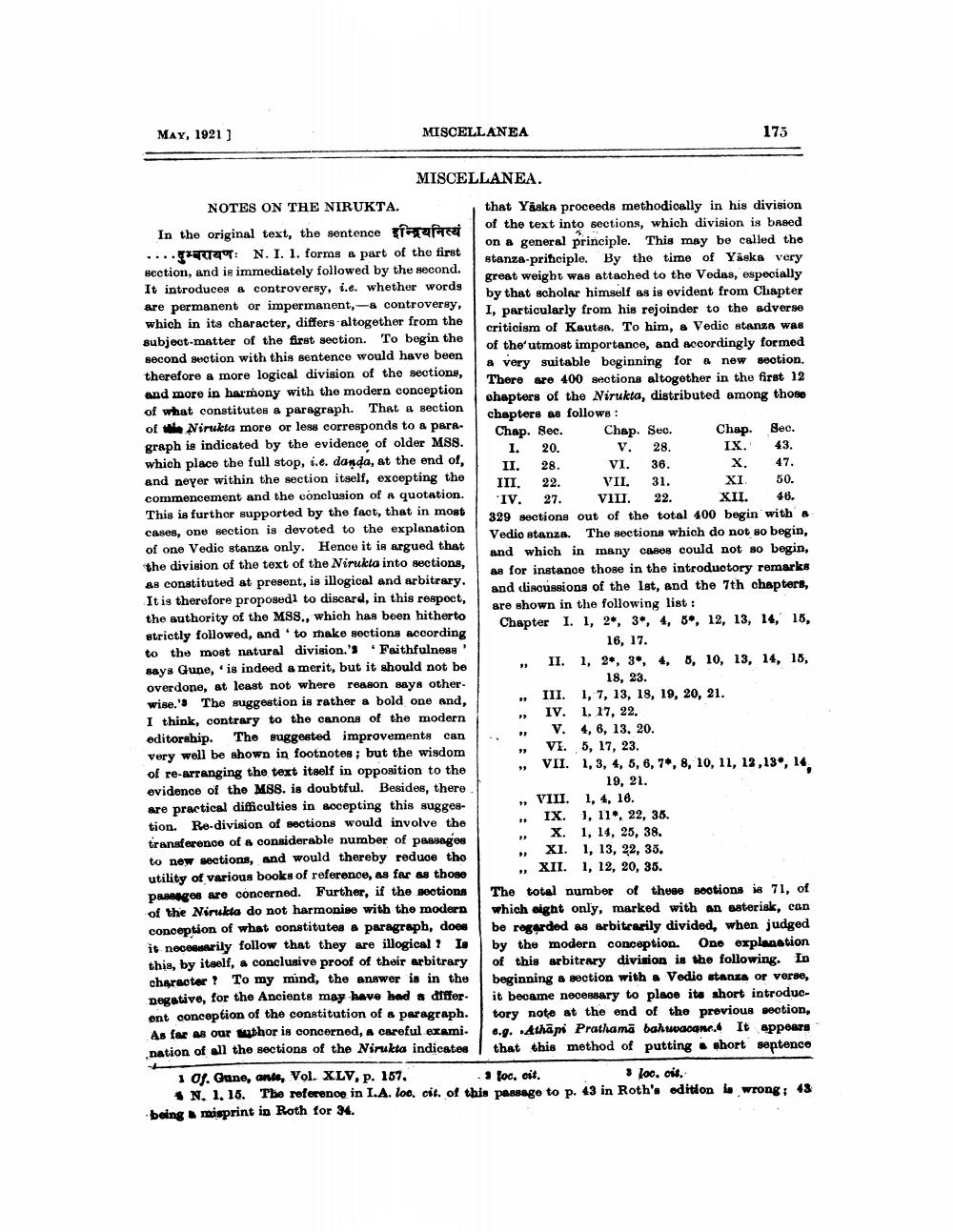________________
MAY, 1921]
MISCELLANEA
175
MISCELLANEA.
NOTES ON THE NIRUKTA.
that Yäska proceeds methodically in his division In the original text, the sontence for free
of the text into sections, which division is breed
on a general principle. This may be called the .... : N. I. 1. forms a part of the first
stanza-prifciple. By the time of Yiska very section, and is immediately followed by the second.
great weight was attached to the Vedas, especially It introduces a controversy, i.e. whether words
by that scholar himself as is evident from Chapter are permanent or impermanent,-a controversy,
I, particularly from his rejoinder to the adverse which in its character, differs altogether from the
criticism of Kautsa. To him, a Vedio stanza was subject matter of the first section. To bogin the
of the utmost importance, and accordingly formed second section with this sentence would have been
a very suitable beginning for a new section. therefore a more logical division of the sections,
There are 400 sections altogether in the first 12 and more in harmony with the modern conception
chapters of the Nirukta, distributed among those of what constitutes a paragraph. That a section
chapters as follows: of Nirukta more or less corresponds to a para
Chap. Sec. Chap. Sec. Chap. Sec. graph is indicated by the evidence of older M88.
1. 20. V. 28.
IX. 43. which place the full stop, i.e. danda, at the end of,
II. 28. VI. 36.
x 47. and neyer within the section itself, excepting the
III. 22. VII. 31. XI. 50. commencement and the conclusion of a quotation.
IV. 27. VIII. 22. XII. 46. This is further supported by the fact, that in most
329 sections out of the total 400 begin with Cases, one section is devoted to the explanation
Vedio stanza. The sections which do not so begin, of one Vedic stanza only. Hence it is argued that
and which in many cases could not so bogin, the division of the text of the Ninukta into sections,
as for instance those in the introduotory remarks as constituted at present, is illogical and arbitrary,
and clincussions of the lat, and the 7th chapters, It is therefore proposedi to discard, in this respoct,
are shown in the following list : the authority of the M88., which has been hitherto
Chapter I. 1, 2, 3, 4, 5*, 12, 13, 14, 15, strictly followed, and to make sections according
16, 17. to the most natural division.'s Faithfulness' says Gune, is indeed a merit, but it should not be
II. 1, 2, 3, 4, 8, 10, 13, 14, 18, overdone, at least not where reason says other
18, 23. wise.' The suggestion is rather a bold one and,
III. 1, 7, 13, 18, 19, 20, 21. I think, contrary to the canone of the modern
IV. 1. 17, 22. editorship. The suggested improvements can
V. 4, 6, 13, 20. very well be shown in footnotes; but the wisdom
VI. 5, 17, 23. of re-arranging the text itself in opposition to the
VII. 1, 3, 4, 5, 6, 7, 8, 10, 11, 12, 13, 14, evidence of the M88. is doubtful. Besides, there
19, 21. are practical difficulties in accepting this sugges
VIII. 1, 4, 18. tion. Ro-division of sections would involve the
. IX. 1, 11, 22, 36. transference of a considerable number of passages
, X. 1, 14, 25, 38. to now sections, and would thereby reduce the
. XI. 1, 13, 22, 35. utility of various books of reference, as far as those
,, XII. 1, 12, 20, 35. Pasanges are concerned. Further, if the sections The total number of these sections is 71, of of the Ninukta do not harmonise with the modern which might only, marked with an asterisk, can conception of what constitutes a paragraph, does be regarded as arbitrarily divided, when judged it necessarily follow that they are illogical 1 I. by the modern conception. One explanation this, by itself, a conclusive proof of their arbitrary of this arbitrary division is the following. In character ? To my mind, the answer is in the beginning & section with Vedio stanza or verse, Degative, for the Ancients may have had a differ it became necessary to place its short introducent conception of the constitution of a paragraph. tory noto at the end of the previous section,
As far as our Mathor is concerned, A careful exami. 6.9. Athäpi Prathamā bahwacane. It appears .nation of all the sections of the Nirukta indicates that this method of putting short septence 1 of. Gune, ante, Vol. XLV, p. 167.
loc. cit. N. 1. 16. The reference in I.A. 1oo. cit. of this passage to p. 43 in Roth's edition wrong: 18 being misprint in Roth for *.




